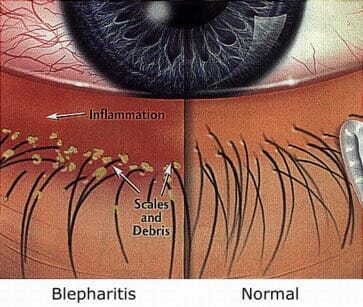A Condition Affecting the Eyelids

Blepharitis is a condition affecting the eyelids, in which inflammation of the tissues surrounding the eyes causes discomfort in those afflicted. The condition is typically caused by an excess in the growth of the naturally occurring bacteria in and around the eyes. This excess can lead to the blockage of the oil glands in the eyelids.
In some patients, a hormonally caused blockage of the oil glands in the eyelids can lead to the appearance of blepharitis as well. Additionally, to a lesser extent, seasonal allergies can also be responsible for blepharitis in some patients.
Symptoms of Blepharitis
Symptoms of blepharitis can include red, itchy and somewhat swollen and scaly eyelids; dry, irritated eyes; the feeling in the patient that something is stuck in the eye; sensitivity to bright lights; red, swollen eyelids; reddening of the whites of the eyes themselves; blurred vision; dry eye; and the accumulation of crusty deposits in the eyelashes.
Blepharitis is a condition, not a disease. It can be controlled through treatment and the adoption of better hygiene, but it cannot be cured. If left untreated, blepharitis can, in time, cause conditions of a more serious nature. Over time, the tissues surrounding the eyes may develop scarring, or other serious problems.
To treat blepharitis at home, apply a clean, warm, damp washcloth to the affected area for several minutes. The washcloth should be moist, but not excessively wet. If the washcloth cools to the point where it is uncomfortable, re-wet it as necessary. The warm wet cloth will help to soften and loosen the crust accumulated around the eye.
After the washcloth has loosened the crust around the eye, re-wet it and apply a diluted solution of mild soap, working it into the cloth. Close one eye, and using a finger, gently rub the soapy washcloth along the eyelids to remove the crust and oily debris loosened by the application of the warm compress.
Remember to rub gently, in order to keep the debris from entering the eye. Once all of the crust and debris has been removed, rinse the eyelids gently with warm water and pat them dry. If, despite proper hygiene, the condition continues to present itself, it may be an indication of a hormonal imbalance that should be looked into by a physician.
[Photo Via: Improve Eyesight]

